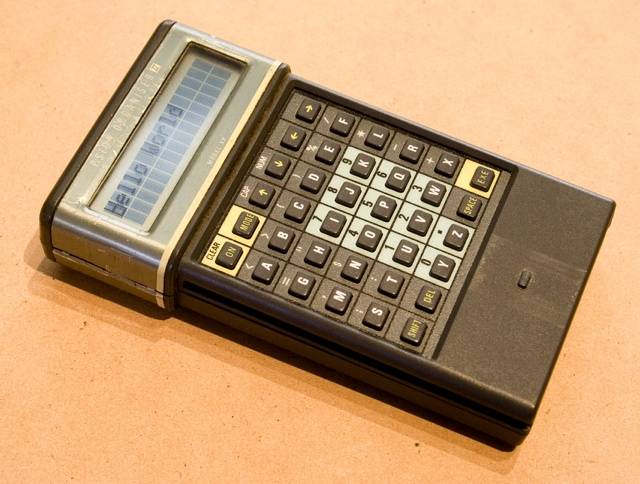Original URL: https://www.theregister.com/2014/03/07/bugger_my_jetpack_wheres_my_21stcentury_psion/
Bugger the jetpack, where's my 21st-century Psion?
Forgotten form factors #2: The handheld PC
Posted in Personal Tech, 7th March 2014 10:04 GMT
Way back in 2011 we covered a handy category of portable computer that has completely disappeared. The early A4 portables were a specialist item, much beloved of journalists but not a big hit with the wider world. It took a different design to win those hearts.
But to start with, let's look at an early ancestor: the Psion Organiser. They weren't pretty, but they were functional – well, for 1984. The Organiser II LZ in 1989 was the one that first tempted me, flush with the earnings of my first job. It boasted a four-line screen, which was just about enough to get by, but its main drawback was its keyboard: a terrible alphabetical-order calculator-style job. Even entering names and addresses into it was a chore; you really would not have wanted to edit text on the thing.
By the time that Organiser II LZ shipped, there had already been a palmtop "PC" (sort of) – the DIP Pocket PC. As its packaging proudly said, it was "Designed in Britain, Made in Japan" – the former part by ex-Psion engineers.
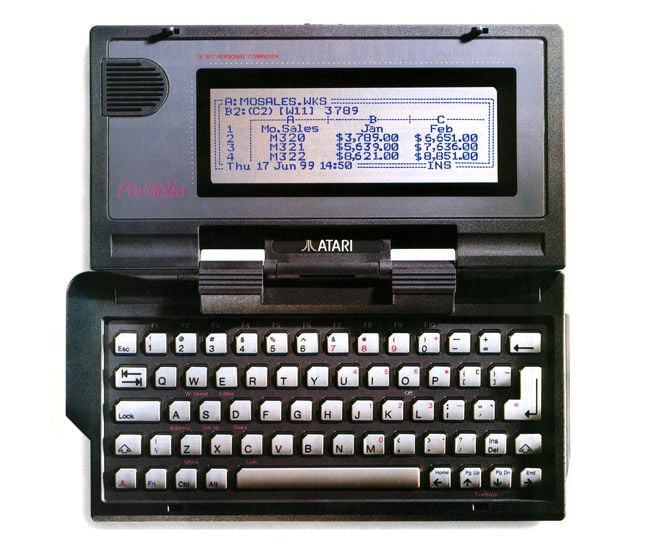
Here's one we made earlier
Made famous in the rebadged version sold by Atari as the Portfolio, it wasn't much of a PC – 40x8 mono screen, 128kB of total storage (that's RAM and the C: drive put together, folks) and a proprietary OS mostly compatible with MS-DOS 2.11. But it could do useful stuff – diary, address book and a spreadsheet – and ran for a claimed month on 3 AA batteries.
The next year, a much-less-constrained – and much more expensive – device went on sale: the Poqet PC.
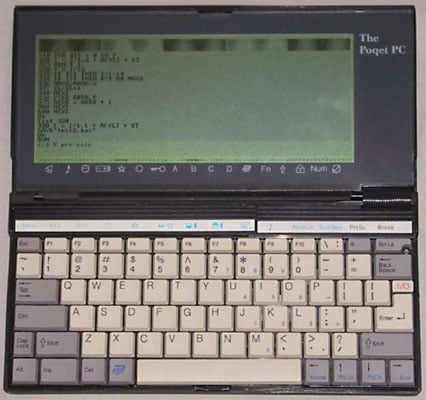
Out-of-Poqet: 1989 palmtop king
It had a full 640kB of RAM, a full 8MHz CPU and cost a full $2,000 to the Portfolio's $399. It also claimed 50 to 100 hours of life out of just two AAs – unless you ran something very CPU-intensive, when this shrank to 10 to 20 hours.
Tight fit
The next attempt at a pocket-sized PC came from Hewlett-Packard – but not from the PC division. In 1991, the HP 95LX came from the calculator division, squeezing 512kB of RAM, a 240x128 pixel (40x16 character) screen, MS-DOS 3.2 and a keyboard – complete with numeric keypad – into a pocket-sized, 310g device for $699. Essentially a pocketable Lotus 1-2-3 machine, it also included a sophisticated financial calculator app: HP calculators were the leading tools of their type at this time, and the top-spec model was half the price of the 95LX.
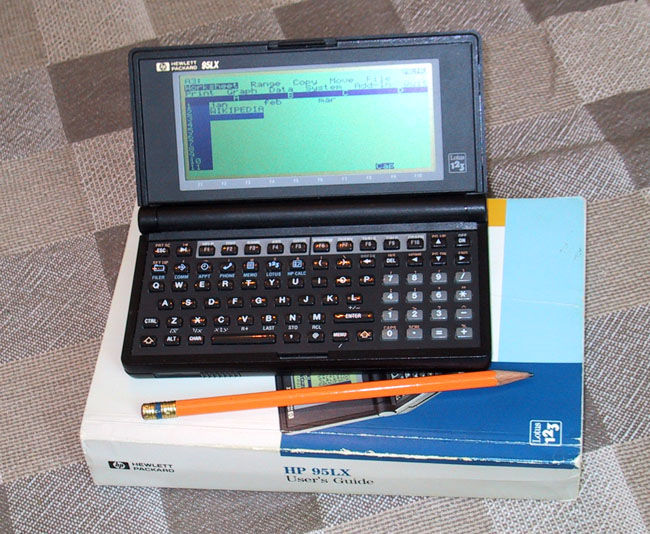
From the calculator boys...the HP 95LX. Source: WT Shymanski
The 95LX was a bigger success than any of its predecessors, selling 400,000 units – but it was still seriously constrained. It didn't have the spec to run full desktop apps and DOS was not a convenient OS for a "personal digital assistant".
The device that redefined this category appeared later the same year – and like the Portfolio, it was British.
Psion's first attempt to follow on from the Organizer range was a range of laptops in 1989: the MC200, MC400 and DOS-compatible MC600. The lower-end models ran Psion's own OS, EPOC, later retrospectively renamed SIBO to distinguish it from its 32-bit successor. SIBO was an impressive achievement – a complete multitasking GUI running on an 8086 with 256kB of RAM.
The most desirable model, oddly, was the midrange MC400 model – but at £845, it was beaten by PC laptops. Psion's response was to re-engineer their device for a less-crowded market sector: the pocket.
By the time the famed Psion Series 3 shipped in 1991, others had pioneered the trail of pocket-sized 8086 computers. Atari's Portfolio and the HP 95LX showed that you could create such a device for a reasonable price, but it was then too compromised to be a general-purpose MS-DOS PC, and the Poqet PC showed that whereas a no-compromise PC was technically viable, it ended up costing more than a laptop.
Psion took a third direction – retaining and enhancing its proprietary OS but modifying the GUI for a small screen and keyboard-driven operation, and bundling it with a complete suite of apps in the ROM: a database, word-processor, spreadsheet with charting functionality, a world clock, a programming language and an Agenda program which to this day remains one of the best ever written for any platform.
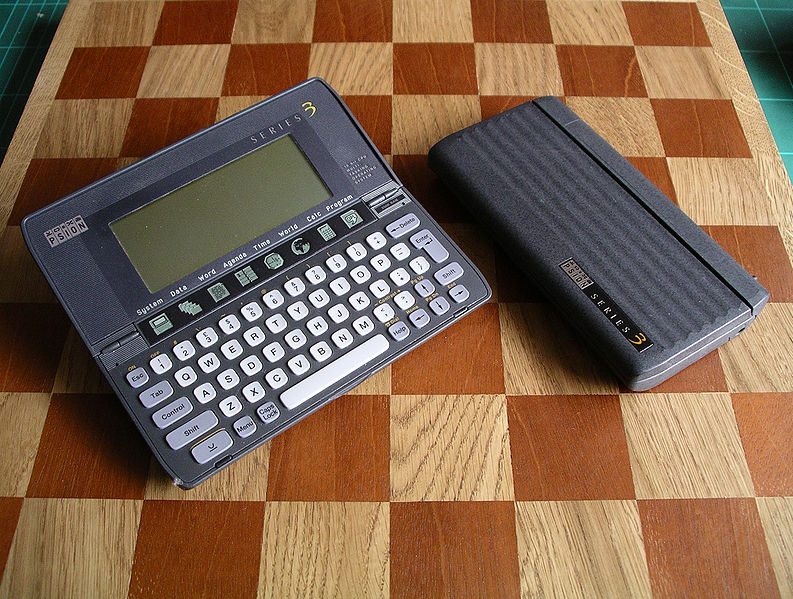
Psion Series 3: had we but world clock enough and time
Compared to the DOS-compatible competition, it was another world: even the lowest-end 128kB RAM Psion 3 could flip between the graphical Agenda, address book and word processor programs with responsiveness and stability to provoke envy in the owner of a desktop PC with the then-current Windows 3.0.
The screen was small, the keyboard a "chiclet" type, but the flexibility and power of even the £179 entry-level model was remarkable. Its hardware design was impressive, too, with a clever (if fragile) pivoting hinge that meant that both halves of the machine were thinner than its own batteries. When open, the upwards-facing part of the battery compartment had a touch-sensitive membrane containing a row of buttons for quickly launching or switching apps.
The good times are coming
The real sweet spot for the 8086 handheld came in the next two years, though, when both companies delivered tweaked second models: the HP 200LX in 1994 and the Series 3A in 1995. Both sported bigger screens – Psion's 480x160 and HP's a CGA-resolution 640x200 – and both now came with up to 2MB of RAM, giving them room for multiple apps – and considerable space for user data, by mid-1990s standards. Finally, use without additional storage was entirely viable.
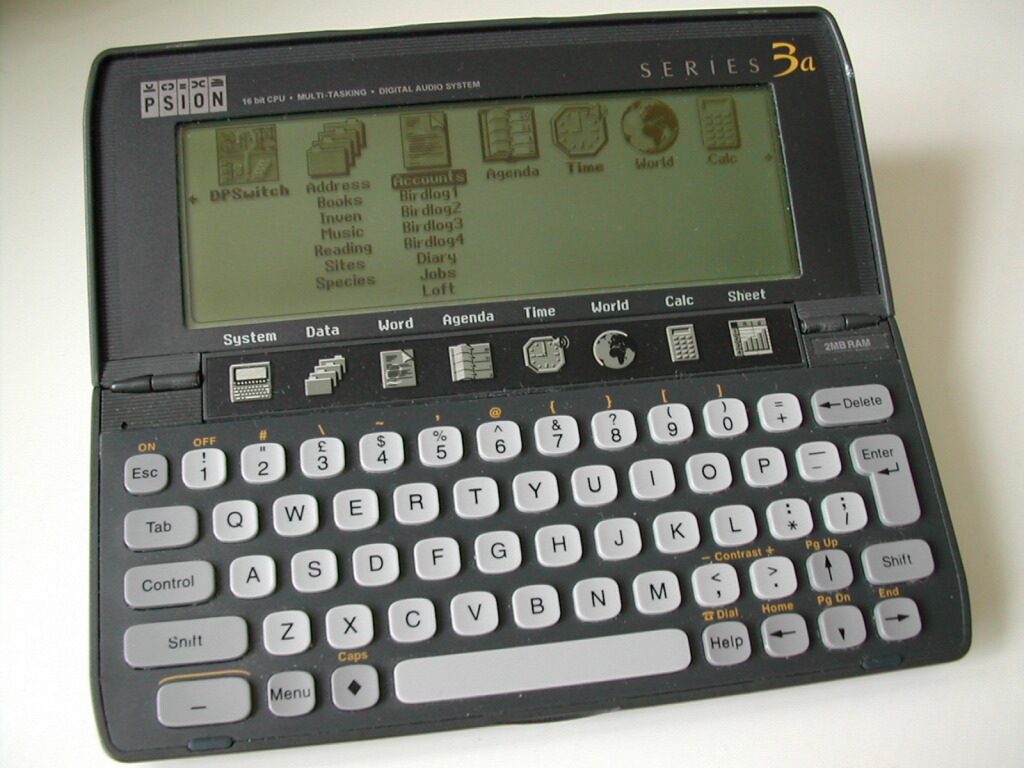
Psion's 3A series: Bigger... but was it better?
The desktop OS of choice was now Windows 3.1, so an LX still wasn't a laptop in your pocket – but with Lotus 1-2-3, cc:Mail and the high-powered calculator all in ROM, they're still used by a few determined fans even today – as are Psions. There was still a clear demarcation between the rival devices: HP's LX range were very much business tools, whereas the Psions were personal assistants you could carry on your person and use to manage your life.
Psions also sported their own built-in programming language and a thriving software market, and the company went on to enhance its range further, with faster processors, infra-red ports and screen backlights, but the focus of development now was the next generation.
Risky business
The next and arguably last big step for the handhelds came in 1997, when the two leading players once again both released their next-gen offerings: the Psion 5 and the HP 300LX. This time, though, Psion clearly had the upper hand. Its ARM CPU and proprietary in-house OS – a complete rewrite called EPOC32 – meant market-beating performance and battery life. It did come as a shock to those of us upgrading from Series 3s, though – the new OS was completely incompatible with the old, driven by touchscreen rather than keystroke, and some of the new apps were weaker than their predecessors, Agenda notably among them.
HP struck off in a different direction with the 300LX and its successors, switching to a Hitachi SH3 RISC chip and Windows CE – known not-at-all affectionately as "Wince". WinCE looked rather like (but was binary-incompatible with) Windows 95, so desktop users could adapt easily – but it was sluggish, and the very simplified CE-edition apps were feature-poor. The 300LX was chunky, too, at 430g and 29mm thick (versus Psion's 23mm and 350g.)
It would take another couple of years for both ranges to hit their second generation and really flower.
For many – including your humble scribe – the updated Psion 5MX from 1999 remains the non plus ultra of handheld computers.
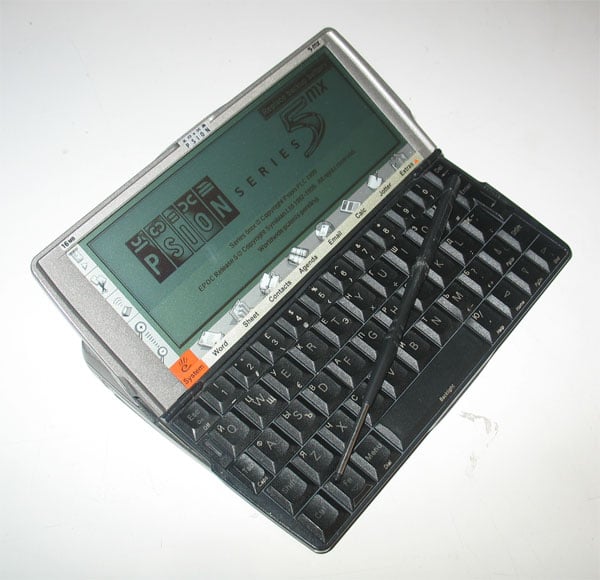
1999's Psion 5MX
Specs-wise, it was a modest step up from the Series 5 – still only a mono screen (albeit much improved), but more memory and twice the CPU speed, although we're still only talking about 36MHz and 8/16MB RAM. However, the device ran for 10 to 20 hours on a pair of AA batteries, and sleeping and waking were genuinely instant, meaning weeks of actual use on a single set of alkalines. The 5MX preserved the superb keyboard and svelte 350g weight from the first model.
HP's LX range gradually ballooned, with faster CPUs, more memory, better screens and additional card slots. The 320LX added a CF slot, a backlight and 12g. The 620LX had a colour screen, was 36mm thick and weighed 586g.
Decline and fall
Finally, in 1999, HP dropped the old LX name and switched from Hitachi SH3 processors to the now well-established ARM for the last generation of HP handhelds. The HP Jornada 720 was a Psion on steroids, boasting a 206MHz StrongARM, an onboard 56K modem, a third card slot for Smartmedia – and despite all this, dropped the baby weight for a muscly 34mm and 515g.
But steroid abuse can lead to bloating, and despite being half a kilo, the lardy Jornada only delivered nine hours of battery life – under half the Psion's. The simple laptop-style clamshell design also meant that the HP tended to topple over backwards if you tapped the touchscreen firmly, whereas Psion's conjoined screen and keyboard slid down as you opened the device into a relaxed, stable slouch – at the price of a fixed screen angle.
HP bowed out of the handheld market in 2002 with the Jornada 728, which doubled the RAM to 64MB and changed the colour scheme... but this wasn't quite the end of the palmtop PC.
The last gasps of the handheld PC were two Japanese devices in 2003. NEC's MobilePro 900c slightly pushed the "handheld" size limits, being 246mm (9.7") wide with an 8.1" screen and weighed a hefty 830g – around the size of the Sony Vaio-P netbook – although it still had the basic 640x240 screen resolution. As such, the crown for the highest-spec handheld probably belongs to the Sigmarion III from Japanese mobile telco NTT DoCoMo.
The Sigmarion III was a sleek 21mm thick, although it was about 2cm wider and longer than a Psion 5MX and weighed 125g more. In there were 64MB of RAM, an 800x480 screen and a 400MHz XScale PXA255 ARM chip, along with CF and MMC/SDIO slots. The screen was a tad cramped due to two columns of touchscreen buttons down the left and right edges, and if you manage to find one on eBay, you'll have to contend with a Japanese keyboard, but it's as capable as handheld PCs ever managed to become.
A plethora of other devices have multiplied in this time, of course – some with tiny QWERTY keyboards, but ones too small for typing or editing large amounts of text.
Where did the good times go?
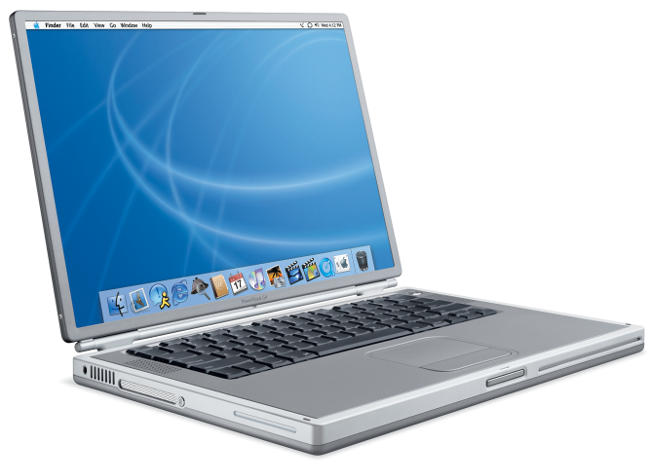
Five whole hours battery life – the Titanium Powerbook was a revelation... at the time
By 2003, notebooks were slim, powerful, elegant devices – Apple's Titanium Powerbook G4 appeared before the Jornada 720. Wi-Fi was de rigueur, but the chipsets sucked too much power for a pair of double-As.
Early-noughties operating systems weren't up to it, either. WinCE was way too limited, and EPOC had become Symbian and had much of its functionality stripped out so it could fit into smartphones. Meanwhile, Linux wasn't ready yet – the specs of a pocket-sized device had a long way to grow before FOSS could deliver a smooth, fast GUI in an inexpensive pocket-sized device. Arguably, 2007 was the year this was demonstrated, in the form of the original iPhone.
But that doesn't explain why they haven't come back. Today, the technology requirements are very modest – there are usable $49 Android 4 tablets coming out of China. They're not brilliant tablets, but they work. Some people, of course, love their fondleslabs: they want to read ebooks, watch movies or play games on the sofa or in bed, and why shouldn't they.
But some of us aspire to produce more than we consume, and would have more use for a pocket-sized writing machine – not to replace a smartphone, but as a supplementary device. Something far smaller than a notebook or even the late lamented netbook: something that's just big enough to show a full page width, just big enough to type on and just small enough to stash away in a jacket pocket on the off-chance that you might need it. Cloud sync now makes it perfectly reasonable to run multiple devices with the same data shared across all of them.
The Jornadas and their ilk were nowhere near as elegant as Psion's gorgeous but heavily patented design. However, enough different companies made devices in that form factor that a modern version should face no legal threats.
If someone had the capital to pay one of the many Shenzhen phone makers to knock out a killer Android handheld PC, many a former Psion owner would be queuing up to order one. I certainly would. ®
